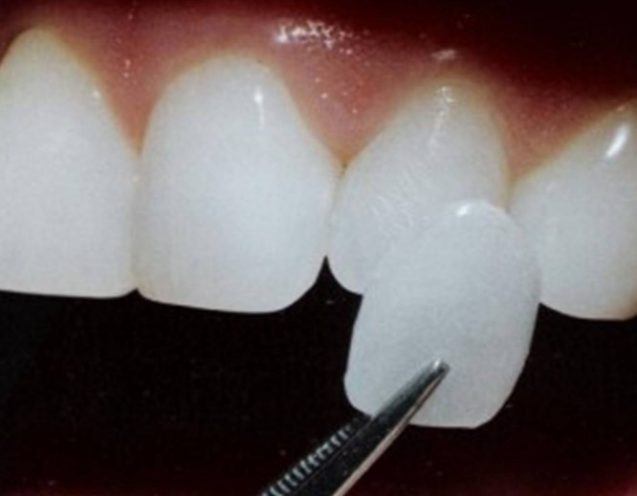Table of Contents [show]
Many patients express the desire to improve their smile. While whitening teeth or getting braces are common methods of improving a patient’s smile, Veneers are an often overlooked option to help transform teeth. Read more to find out more about Veneers.
What Are Veneers?
Veneers are a cosmetic dentistry practice that involved bonding pieces of thin ceramic material to the teeth. Just like a thin piece of an attractive wood is placed over a furniture base, Veneers are placed over the teeth to help them appear whiter, straighter, and more attractive. Veneers simply cover the teeth and are not considered a major dental procedure.
How Are Veneers Applied?
Veneers require multiple steps before application. Learn more about the process.

Dental Examination
The process of applying Veneers begins with a dental examination to determine if the patient’s teeth are healthy and to see if Veneers will help the overall aesthetics of their smile. Often, dentists take oral x-rays and made impressions of the patient’s teeth to evaluate their oral health.
Choosing Veneers
Once a dentist determines that Veneers are a good option for the patient, the dentist must decide which type of Veneers are best. There are 2 types: traditional and minimal prep. Traditional Veneers require the dentist to remove a small layer of the patient’s tooth enamel. This layer is about 0.5mm thick. To put that in perspective, people generally lose more tooth enamel doing day-to-day activities like eating or drinking acidic beverages. Minimal prep Veneers don’t require as much enamel to be removed, if any.
Preparing Teeth
The dentist will remove the layer of enamel and shape the final tooth position to prepare for the application of the Veneers. The dentist will make a mold of the patient’s teeth. This mold is sent to a dental laboratory where technicians sculpt the Veneers based on the mold.
Creating the Veneers
In the dental lab, Veneers are crafted from porcelain, which is used in many other cosmetic dentistry procedures like crowns and bridges, because it can be easily shaped and sculpted. This material is biocompatible and feels similar to natural teeth. Additionally, porcelain can be made in a range of shades to match the right color to the patient. This process can take up to 2 weeks.
Test Fit
The completed Veneers are sent back to the dental office, and the patient returns for the application. The dentist will place the Veneers to make sure the fit is right. If needed, the dentist can make minor adjustments.
Etching
After the dentist assures that the Veneers will fit properly, the tooth is etched. Etching involves using acid to make the surface of a tooth more rough to improve the bonding process.
Application
The dentist will apply cement to the Veneer and to the teeth and will place the Veneers over the teeth. After the Veneers are in their proper position, the dentist cures the cement with a light beam.
This process doesn’t require anesthesia, and patients can walk out of the office with a transformed smile.
How Much Do Veneers Cost?
To be quite honest, there isn’t a set answer. The cost of Veneers depends on the patient and the number of teeth that are being treated. Additionally, dental costs are often affected by geographical location and the dental office itself.
However, Veneers typically cost between $3,000 and $3,500 per tooth. But remember that the cost changes on a case-by-case basis.
Do Veneers Require Special Treatment?
Veneers are strong and can be treated like your normal teeth. Patients can continue to eat and drink what they want and brush with their preferred toothpaste. The porcelain in the Veneers is resistant to staining, although it can still pick up some stains. Many dentists recommend that patients with Veneers avoid smoking, coffee, and red wine.
During normal dental visits, the dentist will continue to check on your Veneers to make sure they are in good condition. Veneers can be polished to restore their original luster and finish if needed.
What Are the Advantages of Veneers?
- Veneers require minimal maintenance.
- Veneers can truly transform teeth. They can cover cracks, stains, minor misalignment, and chips, giving patients confidence in their smile.
- No recovery time.
- Durable.
- Veneers provide natural-looking results.
What Are the Disadvantages of Veneers?
- Veneers last between 10 and 15 years, which means that patients will eventually have to have them replaced.
- The process is not reversible. Veneers require filing down the teeth, meaning they permanently alter your smile. Veneers can be replaced, but patients usually cannot revert to their original look.
- Veneers can be very expensive.
- Veneers cannot correct very misaligned or crooked teeth.
Overall, Veneers are a great option for patients who have small cracks, chips, gaps, or have stains. They can cover these imperfections to give patients an improved and a whiter smile. To find out if Veneers are right for you or if you still have questions about them, contact your dentist.
This post was written by Modern Dental Care in Las Vegas.




